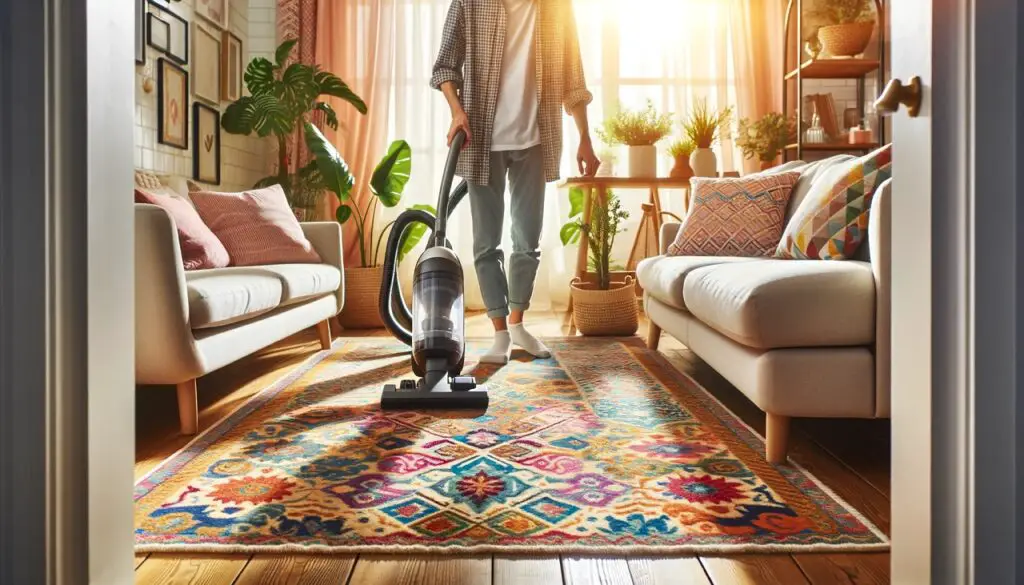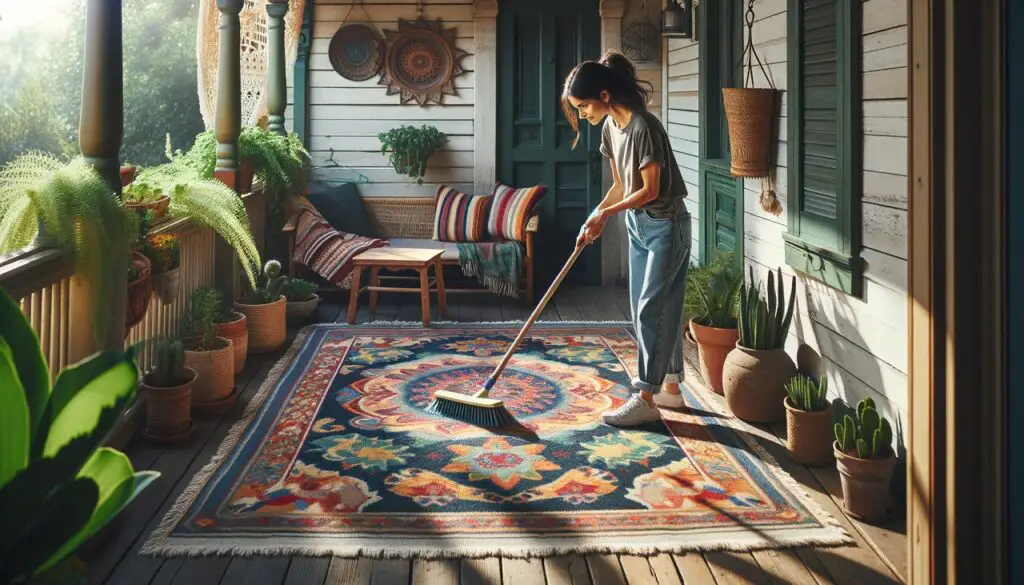Learning how to clean carpet without chemicals is not just an eco-friendly choice but also a healthier one for your home. This comprehensive guide will walk you through various methods to achieve a deep clean for your carpets, using only natural ingredients.

Table of Contents
Understanding the Basics
Before diving into the cleaning methods, it’s important to understand why choosing to clean carpets without chemicals is beneficial. Traditional carpet cleaners often contain harsh chemicals that can leave residues harmful to pets and children. Natural cleaning methods, on the other hand, use safe, non-toxic ingredients that are just as effective in removing dirt and stains while being gentle on your carpet fibers and the environment.
Step 1: Gather Your Materials
To start your carpet cleaning process, you will need a few basic household items. These include a vacuum cleaner, baking soda, white vinegar, a spray bottle, a soft-bristled brush, and clean, dry towels or cloths. Each of these items plays a crucial role in ensuring your carpet gets cleaned effectively without the use of harmful chemicals.
Vacuum Cleaner: A good vacuum cleaner is essential for removing surface dirt and debris from your carpet. This step is crucial as it prepares the carpet for a more thorough cleaning.
Baking Soda: Known for its deodorizing properties, baking soda is effective in removing odors from carpets. It’s a natural, safe alternative to chemical deodorizers.
White Vinegar: This household staple is a powerful natural cleaning agent. When diluted with water, it can help break down stains and odors without damaging your carpet fibers.
Spray Bottle: A spray bottle is needed to apply the vinegar solution evenly across the carpet.
Soft-Bristled Brush: A brush will help in gently agitating the carpet fibers, making it easier to lift dirt and stains.
Towels or Cloths: These are used for blotting and absorbing moisture during the cleaning process.
Step 2: Vacuum Thoroughly
Begin your carpet cleaning by vacuuming thoroughly. This step is crucial as it removes the top layer of dust, dirt, and hair, making the deep cleaning process more effective. Ensure you cover all areas of the carpet, especially high-traffic zones. For best results, vacuum slowly and in multiple directions to agitate the carpet fibers and loosen embedded dirt.
Step 3: Spot Cleaning with Vinegar
For spot cleaning, mix equal parts of water and white vinegar in a spray bottle. Before applying the solution, test it on a small, inconspicuous area of your carpet to ensure colorfastness. Spray the solution lightly onto stains and let it sit for 5-10 minutes. Use a clean cloth to blot the area gently, lifting the stain from the fibers. Avoid rubbing, as this can cause the stain to spread or go deeper into the carpet.
For more articles like this one click here – Carpet Cleaning Guide: Navigating the Maze of Muck and Stains
Step 4: Deodorizing with Baking Soda
Deodorizing your carpet is easy with baking soda. Sprinkle a generous amount of baking soda over the entire carpet, focusing more on areas with stronger odors. Allow the baking soda to sit on the carpet for at least 30 minutes, or overnight for deeper odors. The longer it sits, the more odors it will absorb. After the allotted time, thoroughly vacuum the carpet to remove all the baking soda.

Understanding Carpet Types and Care
Each carpet type has its own unique properties and care requirements. Understanding these differences is crucial for effective cleaning without causing damage. Here’s a closer look at common carpet types and how to care for them:
Wool Carpets: Wool is a natural fiber known for its durability and softness. However, it’s also quite absorbent and sensitive to high pH cleaning solutions. When cleaning wool carpets, use mild, neutral pH cleaners. Avoid bleach and harsh chemicals as they can damage the fibers and cause color fading. It’s best to vacuum wool carpets regularly and address spills immediately with gentle blotting.
Synthetic Carpets (Nylon, Polyester, and Olefin): These carpets are generally more stain-resistant and less sensitive to chemicals. However, they still benefit from non-chemical cleaning approaches. Nylon, being the most durable of the three, can handle more vigorous cleaning, while polyester and olefin are better suited to gentler methods. Regular vacuuming and prompt stain treatment are key to maintaining these carpets.
Berber Carpets: Known for their looped construction and strength, Berber carpets are often made from olefin fibers. They are prone to snagging, so it’s important to avoid using brushes with stiff bristles. Clean spills by blotting rather than rubbing to prevent the loops from becoming frayed.
Shag Carpets: With their long fibers, shag carpets require careful vacuuming to avoid tangling and damage. Use a vacuum without a beater bar or with adjustable height settings. For deep cleaning, a dry-cleaning powder method is recommended to prevent moisture from becoming trapped in the fibers.
Hand-Knotted and Oriental Rugs: These are delicate and often valuable carpets. They should be handled with extreme care. Avoid using water for cleaning as it can cause shrinking or dye bleeding. Instead, vacuum gently and use dry cleaning methods or professional cleaning services specialized in handling such rugs.
Regardless of the carpet type, it’s always advisable to perform a spot test with any cleaning solution in an inconspicuous area to ensure there’s no adverse reaction. Also, consider the carpet’s age and condition. Older or more worn carpets might be more vulnerable to damage and may require professional cleaning.
Finally, always refer to the manufacturer’s care instructions. These guidelines provide specific advice tailored to the material and construction of your carpet, ensuring that you use the safest and most effective cleaning methods.
Dealing with Tough Stains
Stubborn stains on carpets can be challenging, but with the right approach, they can often be removed effectively without resorting to harsh chemicals. Here’s how to tackle some common tough stains:
Homemade Paste for General Stains: For a variety of stubborn stains, a homemade paste can be very effective. Mix equal parts of salt, borax, and white vinegar to create a thick paste. Apply this mixture directly onto the stain and let it sit for several hours or overnight.
The salt and borax work together to break down and absorb the stain, while the vinegar acts as a natural disinfectant. Once the paste has dried, vacuum it up thoroughly. This method works well for stains like mud, food spills, and unknown blemishes.
Organic Stains (Coffee, Blood, Wine): Organic stains, particularly those from coffee, blood, or wine, can be tricky. The key is to act quickly before the stain sets. Blot as much of the spill as possible with a clean, dry cloth.
Then, use cold water to dilute the stain – warm or hot water can cause these types of stains to set into the fibers. For coffee and wine, a solution of one part white vinegar and two parts water can help lift the stain. For blood, try using a small amount of hydrogen peroxide, but first test it on an inconspicuous area to ensure it won’t bleach your carpet.
Oil and Grease Stains: For oil-based stains like grease or lipstick, using a bit of baking soda or cornstarch can be effective. Sprinkle the powder onto the stain and let it absorb the oil for about 15 minutes. Then, vacuum up the powder. Following that, use a cloth dipped in a solution of dish soap and water to gently treat the area, and blot dry.
Pet Stains and Odors: Pet accidents can be a common challenge for carpet owners. First, remove any solid waste, then blot up as much liquid as possible.
A mixture of white vinegar and water can be sprayed onto the area to neutralize both the stain and odor. For more persistent odors, sprinkling baking soda over the area after cleaning and allowing it to sit overnight before vacuuming can be particularly effective.
Remember, with any stain, it’s important to blot rather than rub, as rubbing can spread the stain or push it deeper into the carpet fibers. It’s also critical to address stains as soon as they occur – the longer a stain sits, the more difficult it will be to remove.
Long-term Carpet Maintenance
Maintaining your carpet over the long term is essential to extend its life and keep it looking fresh and clean. Here are some key strategies to help you achieve this:
Regular Vacuuming: Regular vacuuming is one of the most important aspects of carpet maintenance. Aim to vacuum at least once a week, and more frequently in high-traffic areas. This removes surface dirt and prevents it from becoming embedded into the carpet fibers. Use a vacuum with a HEPA filter for best results, as it can capture fine particles and allergens.
Periodic Deep Cleaning: In addition to regular vacuuming, carpets should be deep cleaned every 12-18 months. This can be done professionally or with a rented carpet cleaner. Deep cleaning helps to remove dirt, bacteria, and allergens that regular vacuuming can’t reach. If you have pets or children, or if your carpet sees heavy use, you might need to deep clean more frequently.
Rearranging Furniture: Over time, furniture can cause wear patterns and indentations in your carpet. To prevent this, rearrange your furniture periodically. This not only helps to distribute wear more evenly but also gives you a chance to clean areas of the carpet that are normally hidden under furniture.
Addressing Spills Immediately: Spills should be addressed as soon as they happen to prevent stains from setting in. Blot the spill with a clean, dry cloth, and then clean the area according to the type of spill. Avoid rubbing, as this can work the spill deeper into the carpet fibers.
Using Mats and Rugs: Place mats at all exterior doors to reduce the amount of dirt and debris tracked onto your carpet. Rugs can also be used in high-traffic areas to protect the carpet underneath.
Professional Inspections: Occasionally, it’s a good idea to have your carpet inspected by a professional. They can identify potential issues such as mold growth, wear patterns, or deep-seated dirt that might require special attention.
Avoiding Direct Sunlight: Prolonged exposure to direct sunlight can cause your carpet to fade. Use curtains or blinds to protect your carpet from excessive sun exposure, especially during peak sunlight hours.
By following these tips for long-term carpet maintenance, you can significantly extend the life of your carpet and keep it looking beautiful for years to come.

Environmental Considerations
The decision to clean carpets without chemicals goes beyond personal health benefits; it significantly impacts the environment. Understanding the ecological implications of our cleaning choices is crucial in today’s environmentally-conscious world.
Impact of Chemical Cleaners: Many conventional carpet cleaners contain volatile organic compounds (VOCs) and other harsh chemicals. When used, these substances can evaporate into the air, contributing to indoor air pollution. Poor indoor air quality can lead to health issues like allergies, asthma, and other respiratory problems. Additionally, when these chemicals are washed down the drain, they can contaminate water sources, harming aquatic life and disrupting ecosystems.
Biodegradability of Natural Cleaners: Natural cleaners, on the other hand, are generally biodegradable. Ingredients like vinegar, baking soda, and lemon juice break down naturally in the environment, reducing pollution and minimizing harm to wildlife and ecosystems. This makes them a more sustainable and eco-friendly option for regular use.
Conclusion: How to Clean Carpet Without Chemicals
Cleaning your carpet without chemicals is not only environmentally friendly but also better for your health. The methods described in this guide are simple, effective, and use everyday household items. By following these steps, you can maintain clean, fresh carpets while ensuring a safe environment for your family and pets.